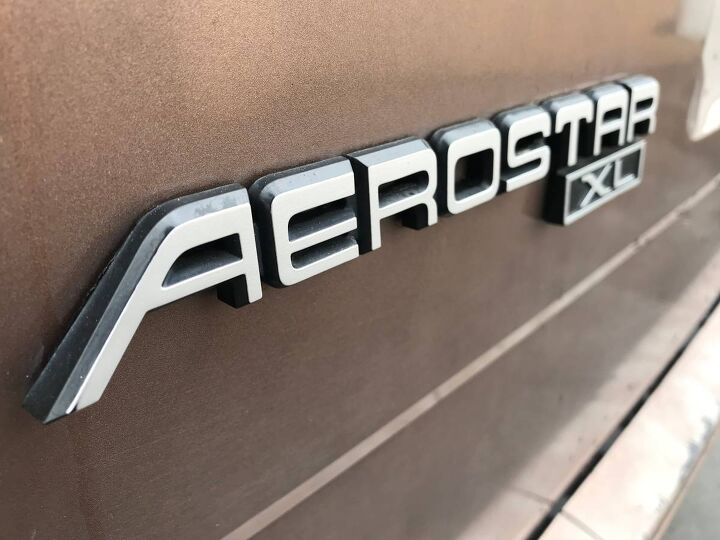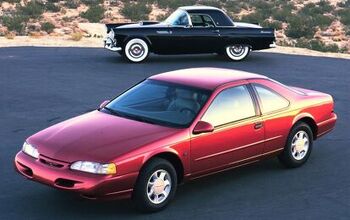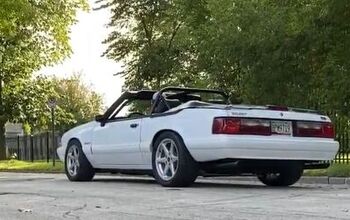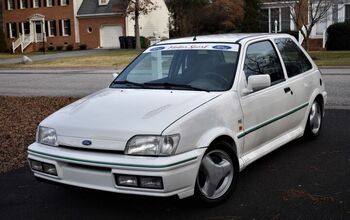Rare Rides: The 1994 Ford Aerostar - Better in Brown

Much like our recently presented Tempo, today’s Ford is a well-kept oddity that’s already considered a classic due to its age. A ho-hum family van, the Aerostar was the sort of vehicle that got well-used and (usually) rusted by its eighth birthday.
Today’s short-wheelbase beauty, however, made it to 26.
In 1984 Chrysler introduced the Dodge Caravan, which simultaneously doomed the large family station wagon, created the minivan segment, secured Chrysler’s financial future, and put General Motors and Ford on their ear. But it didn’t have to be that way. You see, Ford goofed.
In the early Seventies, Ford was working on a derivative of the Econoline van that was smaller and could be parked in a garage (the key component for suburban family buyers). Called the Carousel, in 1976 the rear-drive van was shown to Ford execs and received applause from around the table. But Ford had too many irons in the fire, namely more sexy projects like new Fox and Panther platforms. The project was killed, which increased tensions between Lee Iacocca, engineer Hal Sperlich, and their boss Henry Ford II. In 1978 both men were fired, and found greener pastures with Chrysler. More open to minivan time, Chrysler approved the project in 1979, and the Caravan was underway.
After word broke of a green light on the Caravan, Ford sighed and began its own development of a new minivan. They took the tall, six-foot height of the Carousel as a starting point, and started over. Mini Econoline ideas were scrapped in favor a smaller unibody platform, VN1. Fuel economy was top of buyers’ minds at the time, so plastics were used to reduce weight, while aluminum was used in some places instead of steel. The parts-sharing with Ranger sped up development, and the Aerostar debuted in near-final “concept” form in 1984. It went into production in June of 1985 for the ’86 model year.
Initially all Aerostars were rear-drive, though all-wheel drive became an option in 1990. Standard-length vans measured 174.9 inches, while long-wheelbase versions were 190.3 inches. The base engine was a 2.3-liter inline-four, though this was discontinued after 1987. For 1986 only, Aerostar buyers who desired a middling engine could opt for the 2.8-liter Cologne V6. Two other V6 engines were offered for a longer time: the Vulcan 3.0-liter from ’86 through ’97, and the 4.0-liter Cologne V6 from ’90 to ’97. Transmissions included a five-speed Mazda manual for the first two model years, with a four-speed automatic offered through 1996. For Aerostar’s final model year in ’97, all versions received a five-speed automatic.
While Ford’s first minivan was successful, it couldn’t touch the Chrysler offerings. In a big announcement on March 17, 1997, Ford discontinued a group of its products: the Aspire, Thunderbird, Cougar, Probe, and Aerostar. Only the Aerostar had a successor, replaced in 1998 by the more family-friendly Windstar. The new offering was based on the front-drive Taurus, which secured its future until crossovers came along.
Today’s well-kept and low-mileage Rare Ride is for sale presently in California. In bronze over beige, it asks $2,275.
[Images: seller]

Interested in lots of cars and their various historical contexts. Started writing articles for TTAC in late 2016, when my first posts were QOTDs. From there I started a few new series like Rare Rides, Buy/Drive/Burn, Abandoned History, and most recently Rare Rides Icons. Operating from a home base in Cincinnati, Ohio, a relative auto journalist dead zone. Many of my articles are prompted by something I'll see on social media that sparks my interest and causes me to research. Finding articles and information from the early days of the internet and beyond that covers the little details lost to time: trim packages, color and wheel choices, interior fabrics. Beyond those, I'm fascinated by automotive industry experiments, both failures and successes. Lately I've taken an interest in AI, and generating "what if" type images for car models long dead. Reincarnating a modern Toyota Paseo, Lincoln Mark IX, or Isuzu Trooper through a text prompt is fun. Fun to post them on Twitter too, and watch people overreact. To that end, the social media I use most is Twitter, @CoreyLewis86. I also contribute pieces for Forbes Wheels and Forbes Home.
More by Corey Lewis
Latest Car Reviews
Read moreLatest Product Reviews
Read moreRecent Comments
- Tane94 Blue Mini, love Minis because it's total custom ordering and the S has the BMW turbo engine.
- AZFelix What could possibly go wrong with putting your life in the robotic hands of precision crafted and expertly programmed machinery?
- Orange260z I'm facing the "tire aging out" issue as well - the Conti ECS on my 911 have 2017 date codes but have lots (likely >70%) tread remaining. The tires have spent quite little time in the sun, as the car has become a garage queen and has likely had ~10K kms put on in the last 5 years. I did notice that they were getting harder last year, as the car pushes more in corners and the back end breaks loose under heavy acceleration. I'll have to do a careful inspection for cracks when I get the car out for the summer in the coming weeks.
- VoGhost Interesting comments. Back in reality, AV is already here, and the experience to date has been that AV is far safer than most drivers. But I guess your "news" didn't tell you that, for some reason.
- Doc423 Come try to take it, Pal. Environmental Whacko.







































Comments
Join the conversation
This vehicle has *two* external key cylinders on the passenger side alone! (An incredible extravagance by 2020 standards.)
The Aerostar is not based on the Ranger platform. One has a full frame, the other is a unibody. One had a twin I (or traction) beam front suspension, he other had an SLA set up. One had leaf springs holding up and locating the rear, the other a 3 link and coils. Yes they shared engines and transmissions, but chassis wise it was some brake pieces and the wheels.